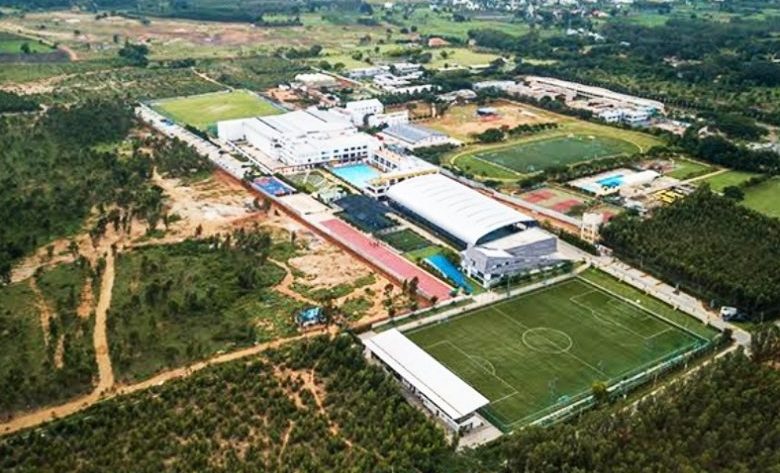NEW DELHI: As Indian athletes begin to compete well with the best in business, it coincides with the excellent infrastructure that has come up in the recent past. Whether it is cricket or Olympic sports, the country is making rapid progress in building cutting-edge facilities that can be termed world class.
Some of these are in public sector while the others — perhaps better, quality-wise — are private undertakings.
Facilities owned by the Sports Authority of India (SAI) in New Delhi and elsewhere in the country have been there for a few decades and have been upgraded at times. However, ultra-modern infrastructure has come up in the private sector more recently. Two prime examples of private state-of-the-art facilities for Olympic sports are the Inspire Institute of Sports (IIS) in Vijayanagara, Karnataka, and the Padukone-Dravid Centre for Sports Excellence (PDCSE) in Bengaluru. The other noteworthy private infrastructure is TransStadia in Ahmedabad.
PDCSE, named after the legendary badminton player Prakash Padukone and former India cricket captain Rahul Dravid, is the other brilliant facility that India can be proud of. It is spread over 15 acres near Bengaluru’s Kempegowda International Airport and was opened in 2017.
The PDSCE has facilities for badminton (16 courts), cricket (12 outdoor and 12 indoor pitches, a nursery ground), and football (international size flood-lit FIFA approved artificial turf ground). It also has modern facilities for swimming (top-of-the-line 50 metre, 10-lane pool besides a heated 20-metre indoor pool for beginners), squash (four world-class glass-backed courts with spectators’ gallery), shooting (10 meters, 6 lanes range), tennis (5 covered hard courts and 5 quick-start courts), and basketball.
The centre includes support facilities such as the SAI-Abhinav Bindra Targeting Performance (ABTP) centre, an advanced sports science centre, and hostel facility for 350 athletes, 150 of which are reserved for badminton players.
The Prakash Padukone Badminton Academy is a prominent branch of the PDSCE. Founded by Padukone, a former World Cup and All England winner, along with U. Vimal Kumar, a 1986 Asian Games bronze medallist, and thrice Karnataka champion Vivek Kumar, the academy was launched in 1994 in Bengaluru. The Bengaluru facility has 16 badminton courts. Later, its branch was opened at Mumbai’s Cricket Club of India in 2009.
“We were the first private badminton academy anywhere in the world. In any other country, these sorts of facilities are all government facilities or funded by the government. We have government funding now but back then it was a private academy. Prakash’s name was very big so that’s how we started the academy with his name,” Vimal Kumar told IANS.
“We founded this academy with the intention of helping national level to perform at the international level. Electronics company BPL was one of our earliest supporters. All the top players in the country like Pullela Gopichand and Aparna Popat joined us and trained here,” the two-time national singles champion pointed out.
About the PDCSE, Vimal said that Vivek took the initiative. “He was looking after the business part of it while me and Prakash looked after the academy. He said that we should build our own infrastructure and he got this entire complex built and dedicated the facility to Prakash and Dravid,” he recalled.
Spread over 42 acres, the focus of Inspire Institute of Sports (IIS) is mainly in four Olympic disciplines — track and field, boxing, judo, and wrestling. The campus has an eight-lane 400 metres synthetic track and 200 metre grass track. The 62mx62m combat hall can accommodate three boxing rings, three judo mats, and three wrestling mats. It also gives athletes access to schools/colleges, hospitals, and entertainment options in its neighbourhood.
“The IIS campus also has a 300-bed residential wing for athletes. The campus also has a high-performance centre having a multi-gym spread over a 16,000 square feet area. There is a massage room and sports lab facilities too. A 50m indoor track is also part of the rehab centre,” an IIS official told IANS.
World Championships medallist Bajrang Punia and 2016 Olympic bronze medallist Sakshi Malik are among several top wrestlers who often visit the IIS complex when not attending national camps.
In 2019, post his elbow surgery, Asia Games gold medallist javelin thrower Neeraj Chopra used the IIS rehabilitation centre to strengthen his muscles and improve his fitness. It helped him to earn a quota for this year’s Tokyo Olympic Games.
TransStadia in Ahmedabad is a public private partnership project that covers sports, entertainment, hospitality, and talent development. The multipurpose sports complex was opened in 2016. The outdoor football complex has a capacity of 20,000. If temporary stands are set up the seating capacity can go up by an additional 10,000.
The football stadium played host to the 2019 Continental Cup. It was one of the venues for the 2020 FIFA under-17 Women’s World Cup. But the tournament was postponed due to the Covid pandemic.
The indoor arena has 4,000 seating capacity. It was the venue for the 2016 Kabaddi World Cup and also for the Pro-Kabaddi League matches.
In cricket, India boasts several excellent stadiums and academies. Some of these are owned privately and some belong to the affiliates of the Board of Control for Cricket in India (BCCI). In recent times, many such stadia have come up in second-tier cities, an important indication of the spread of cricket in the hinterland.
The Vidarbha Cricket Association (VCA) stadium in Jamtha village near Nagpur in Maharashtra, along with the Narendra Modi Stadium in Motera, near Ahmedabad, are the best examples of modern cricket stadiums built in India.
The VCA Stadium, owned by the Vidarbha Cricket Association, is built on 34 acres land and its construction cost came to around Rs.90 crore, including the attached clubhouse. It was completed in 2008 and all international matches are now played there, replacing the old stadium in Civil Lines inside Nagpur city. Among the salient features of the stadium are separate gymnasiums attached to both dressing rooms, and a secure space for players.
The Narendra Modi Stadium in Motera is the world’s largest cricket stadium and can hold 1,10,000 spectators. It has the ultra-modern floodlights, though on the brim of the overhead shade for spectators all around the ground. It sits on a 63-acreland and cost around Rs. 800 crore. The stadium recently hosted India-England Tests and T20 matches.
The other new stadiums in Rajkot, Gujarat (area: 29 acres, cost: Rs.75 crore approximately, completed in 2008), and Ranchi, Jharkhand (area: 35 acres, cost: Rs.180 crore approximately, completed in 2012), are also worth taking a look at. Baroda too is building a new stadium (area: 33 acres, estimated cost: Rs.180 crore, to be completed next year).
“The Rajkot stadium is spectator-friendly, with good viewing and better facilities. The old stadium didn’t have this. Spectators are very important. To provide them facilities is more important. The BCCI did not have that much money. But since mid-2000s the Board started to earn huge revenues and started investing money in infrastructure,” Niranjan Shah, a former BCCI vice-president and secretary, told IANS.
Interestingly, the BCCI never had its own property. Even its headquarters in Mumbai is operating from a leased-rent building that belongs to the Mumbai Cricket Association. Now, it has purchased from the Karnataka Industrial Areas Development Board 40 acres land on lease near Bengaluru airport to build a state-of-the-art National Cricket Academy. Although the BCCI head office will remain in Mumbai, the ambitious project, once complete, promises to be the best in the world.
The new NCA facility will have a 16,000 square feet gymnasium, 40 practice pitches, 20 of which will have floodlights, 243 rooms of varying shapes and sizes, an open-air theatre and an indoor training facility comprising futsal, squash, badminton, basketball, tennis, cycling track, and temperature-controlled pool etc.
Overall, the picture looks rosy vis-a-vis sports infrastructure. The onus is now on our athletes who need to take maximum advantage of these wonderful, modern facilities, and with its help win medals at global competitions. How about starting with a bagful of medals at the Tokyo Olympics Games this year?





